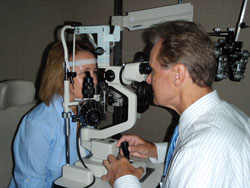
Eye Health Evaluation
Periodic eye and vision examinations are an important part of preventive health care. Many eye and vision problems have no obvious signs or symptoms. As a result, individuals are often unaware that problems exist. Early diagnosis and treatment of eye and vision problems are important for maintaining good vision and eye health, and when possible, preventing vision loss.
Preliminary testing includes visual acuity to measure how each eye is seeing clearly, binocular vision and how the eyes work together, refraction to determine refraction errors, peripheral vision, and pupil response to light.
External examination of the eye includes evaluation of the cornea, eyelids, conjunctiva and surrounding eye tissue using bright light and magnification.
 Evaluation of the lens, retina and posterior section of the eye may be done through a dliated pupil to provide a better view of the internal structures of the eye.
Evaluation of the lens, retina and posterior section of the eye may be done through a dliated pupil to provide a better view of the internal structures of the eye.
Did you know that your eyes reveal insights regarding your overall health?
Illnesses that may be discovered early on through signs in your eyes include high blood pressure, diabetes, and even heart disease. We feel it's important to review your family history, then monitor and watch for signs of possible inherited diseases or illnesses as another precaution.
Here's what we are checking during your routine eye health evaluation
Dry eye - People with dry eyes either do not produce enough tears or have poor quality of tears. Dry eye is a common and often chronic problem. Careful evaluation of blinking patterns and tear film layers of oil and water are needed for effective treatment.
We evaluate for Glaucoma, a disease where high levels of pressure inside of your eye are present when your eyes fail to regulate internal pressure causing damage to the optic nerve. Early detection of glaucoma is crucial to prevent the loss of sight.
We monitor for Cataracts, that describes the condition when the internal lens of our eye becomes cloudy and sometimes needs replacement.
Age-Related Macular Degeneration (AMD) is the leading cause of severe vision loss in adults over age 50. This eye disease occurs when there are changes to the macula, a small portion of the retina that is located on the inside back layer of the eye. AMD is a loss of central vision that can occur in two forms: "dry" or atrophic and "wet" or exudative.
Diabetes and high blood pressure effects the tiny blood vessels that nourish the retina. They can leak blood causing severing of retinal tissue and cloudy vision.
Floaters and small spots or clouds moving around with light flashes may indicate a retinal detachment which, if left untreated, can cause a permanent loss of vision.
Do you know what binocular vision means? It's when each of your eyes forms its own image and transfers these images to the brain. The brain fuses these two images into one. In order for this to occur, your eyes must move together, be aligned, and produce the same size and shape image. When this doesn't happen it's difficult to see clearly and usually causes strain and headaches. We conduct a series of tests that assess the ability of your eye muscles to make sure that both eyes are working as a team!
